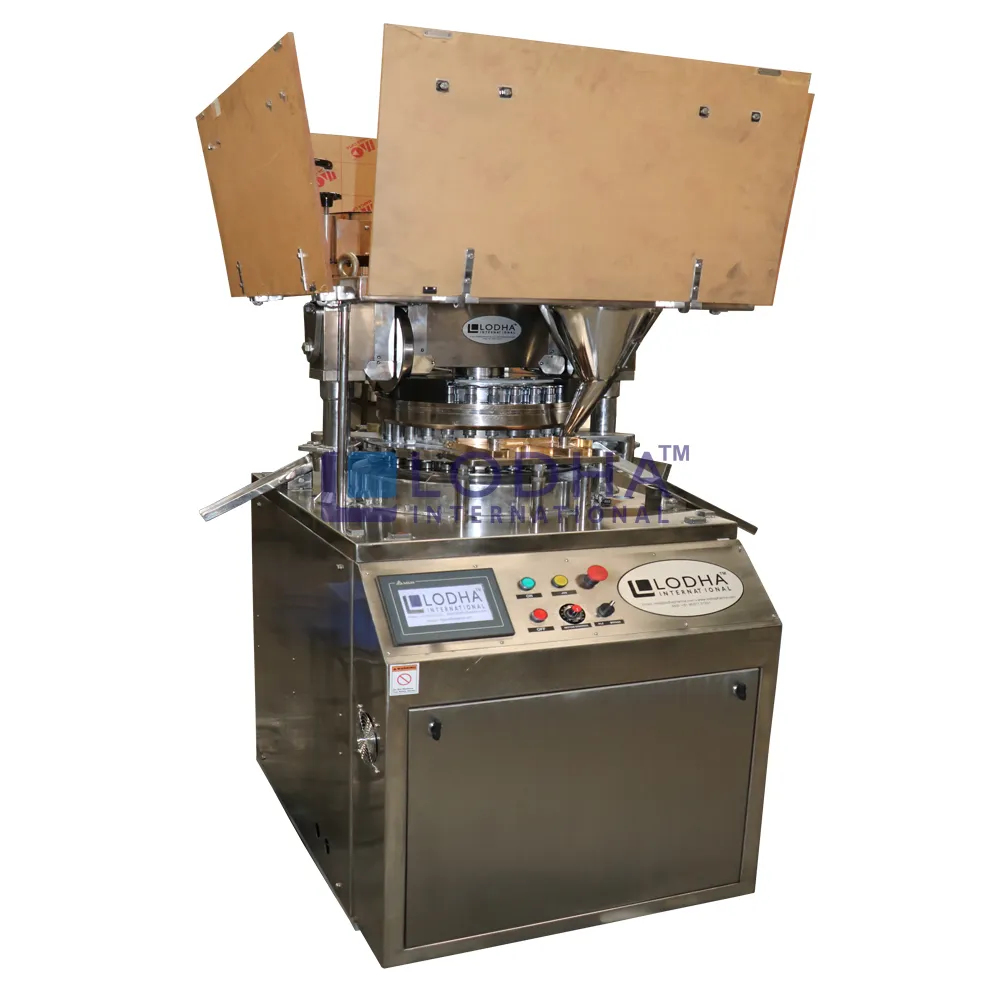Get in touch! +91 9687731331 | +91 9687631331 | info@lodhapharma.com
Tablet Press Machine – An Overview
A tablet press machine is a device used to produce round, double-sided engraved tablets. These machines eliminate the need for human intervention and improve accuracy and consistency. With an ageing population, tablet formulations are becoming more popular as we seek relief from ailments and the onset of age-related illnesses. Tablet manufacturing facilities are also favoured by new developments in pharmaceutical formulations. Single-station presses are also available. However, double rotary presses can produce more than thousands of tablets per hour, which is enough for many heavy tablet manufacturing industries.
Single Punch Tablet Press Machines
A good quality single punch tablet press machine will make the whole process of making tablets simple and straightforward. While selecting a tablet press, there are some things to keep in mind. First, choose the right dies for your needs. Die quality determines the quality of the finished tablet. It is essential to choose high-quality dies for your machine. If you're not sure about which dies are right for your needs, try some of the tips below to make the decision easier.
These components ensure the proper alignment of the dies and punch. They also control the filling and compression process. The system also controls the ejection of the tablets. The punches move in a circular motion, while the die system tooling directs the upper punch up and down through various compression operation phases. The pre-compression roller removes air from the powder, which could compromise the tablet's quality. The main compression rollers apply the final force needed to form tablets.
Rotary Tablet Press Machines
The rotary tablet press machine is a popular choice for manufacturers of oral-care products. Its synchronized compression process and stable rollers enable the production of tablets of high quality. In addition, these machines have the added advantage of managing dust and preventing cross-contamination. The machine is operated by servo and induction motors. Both are ideal for pre-compression and main compression. A synchronized motor directs the upper and lower punches through different compression operation phases. The die system also allows for correct dosing. It can be used either in conjunction with a tablet press machine or separately.

Multi-Punch Tablet Press Machines
A Multi-punch tablet press machine is designed to compress powders into tablets. Its lower punch tracks are adjustable, and the feeding paddle forces the granules into the die. The lower punch is comprised of an upper and lower punch. Both of these punches move within the die bore. During the filling process, the lower punch guides the upper punch upwards with a cam track, which enables accurate adjustment. The take-off blade then moves the tablets to a collection container.
The tooling station consists of a die, an upper punch, and a punch stem. The overall length of the punch is the combination of working length and cup depth. The stem, or straight portion of the punch stem, is the part that extends from the barrel to the edge of the tip. The tablet face is defined by the shape of the tip face or cup. In addition to the stem, the top head also has a flat face, which helps in the filling process.
Single Station Tablet Press Machines
A single station tablet press machine is a compacted device that uses a die cavity to compress the powder material into a tablet dosage. The die comprises a lower punch and an upper punch. The lower punch presses the powder granules in one direction and the upper punch compresses the material while the latter eject the compressed tablet. These two parts are linked.
When purchasing a tablet press machine, choose a cGMP-compliant device from a reputable manufacturer. The tooling used to create the tablets should be cGMP-compliant and feature minimal parts in contact with the product. Ensure the tablet press has a robust construction and few moving parts. Sturdy construction increases the stability and efficiency of the machine. Before purchasing, ask yourself which type is better.
Rotating Turret Tablet Press Machines
The rotary tablet press machine has four main functions: filling, pressing and discharging tablets. A set of cam trucks guides the upper and lower punches to the correct positions in the die cavity. The upper cam pulls out the top punch while the lower cam thrusts the bottom punch upward. This way, the turret rotates without disturbing the powder inside the die cavity.
After cleaning the components and disassembling the machine, it is time to put it back together. The turret assembly represents the core of the tablet press and is the most sensitive to wear and tear. Make sure the turret assembly and die table surfaces are clean and free of damage or excessive wear. If the turret assembly or die table surface is damaged or worn, it should be replaced immediately.
Single Station Multi-Punch Tablet Press Machines
A single-station multi-punch tablet press machine is designed to produce high-quality tablets with minimum waste. Its design consists of a single upper punch and a lower punch that move vertically and make contact with each other during the tablet compressing stage. The pressure between the two punches compacts the powder material, which is governed by the shape of the die cavity. Once the upper punch is withdrawn from the die, the powder falls into the cavity created by the die. Then, the lower punch is ejected and the tablets fall to the discharge chute and are moved to the collection container.
The Bottom Line
A tablet press machine is equipped with multiple punches and dies and is capable of producing hundreds of tablets in a single compression cycle. With the right tablet press, an industry can meet the market demand and enjoy good returns. A multi-station tablet press is equipped with multiple safety features. Its advanced safety features include a compression force alarm. A compression-force alarm will eventually stop the machine before reject tablets are produced.

